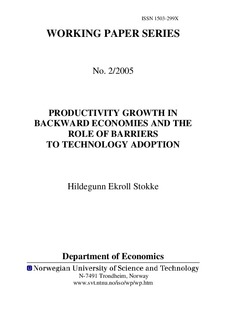| dc.contributor.author | Stokke, Hildegunn E. | nb_NO |
| dc.date.accessioned | 2014-12-19T14:31:49Z | |
| dc.date.available | 2014-12-19T14:31:49Z | |
| dc.date.created | 2006-10-03 | nb_NO |
| dc.date.issued | 2005 | nb_NO |
| dc.identifier | 126073 | nb_NO |
| dc.identifier.uri | http://hdl.handle.net/11250/267109 | |
| dc.description.abstract | We offer a barrier model of growth with a broader understanding of the sources of productivity growth. Organizational change is suggested as an alternative to innovation and technology adoption. Domestic and international barriers (related to the level of human capital and the trade share) determine the timing and pace of technological catch-up, and as opposed to the catchingup hypothesis backward economies may get stuck in a poverty trap. Growth in lagging economies is not driven by adoption of foreign technology due to inappropriateness. The large technological distance forces the economy to rely more on own productivity improvements through organizational change. Trade liberalization in backward economies does not give the expected boost to productivity growth, because of low capability to take advantage of the frontier technology. Economies can escape the poverty trap by reducing trade barriers, but the benefits from an open economy is highest in middle-income economies, which have both the potential and capability to adopt foreign technology. | nb_NO |
| dc.language | eng | nb_NO |
| dc.publisher | Institutt for samfunnsøkonomi | nb_NO |
| dc.relation.ispartofseries | Working Paper Series, 1503-299X; 2005:2 | nb_NO |
| dc.title | Productivity Growth in Backward Economies and the Role of Barriers to Technology Adoption. | nb_NO |
| dc.type | Research report | nb_NO |
| dc.contributor.department | Norges teknisk-naturvitenskapelige universitet, Fakultet for samfunnsvitenskap og teknologiledelse, Institutt for samfunnsøkonomi | nb_NO |
